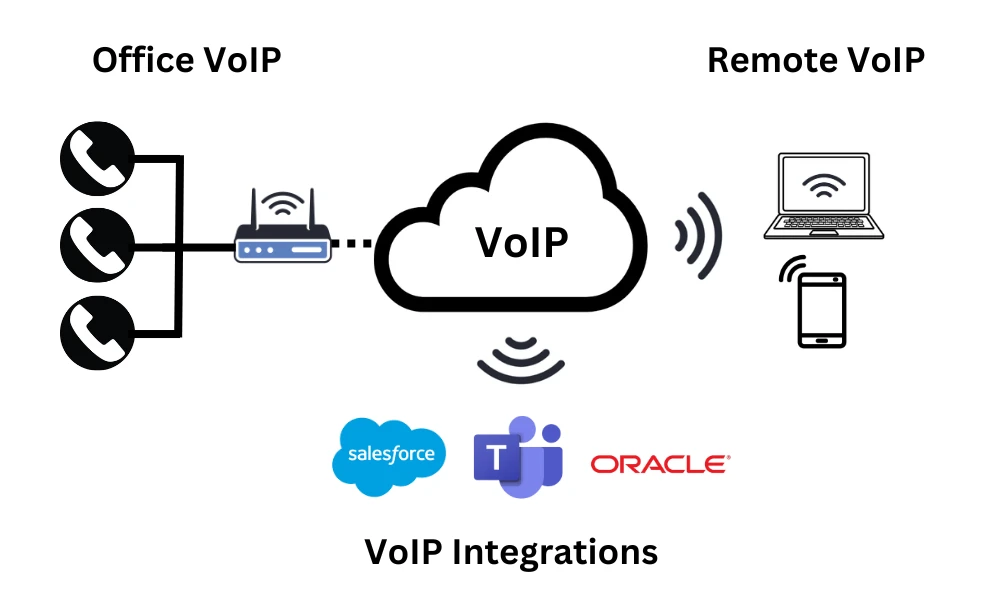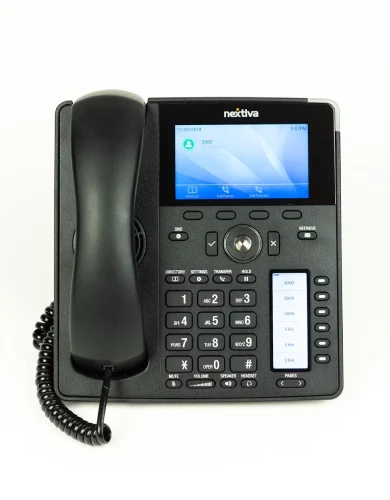Remote VoIP solutions
As hybrid and remote work become the norm, businesses must provide teams with the same tools they use in the office, no matter where they are. Remote VoIP enables this by bringing advanced features like high call quality, security, and integrations to employees working from anywhere.
Whether it’s a financial advisor securely calling clients from home or a logistics team coordinating shipments on the go, remote VoIP ensures seamless, professional communication.
This guide explains remove VoIP solutions, here’s what we cover:
- What is a Remote VoIP solution?
- Who is Remote VoIP for?
- Key features of Remote VoIP
- How to choose a remote VoIP solution
- Best VoIP solutions for remote work
- Troubleshooting remote VoIP
What is a Remote VoIP solution?
A remote VoIP solution extends the benefits of centralised business VoIP systems to employees working outside the office.
This allows your workforce to maintain high VoIP call quality, access advanced VoIP features, integrate with business tools like CRMs, and ensures secure VoIP communication on any device and connection.
For instance, customer support teams can resolve client issues from home while accessing ticketing systems, or sales reps can update CRM records immediately after pitching to clients from a hotel.
Remote VoIP is typically an add-on to business VoIP phone systems, tailored for hybrid or fully remote teams.
How does it work?

Remote VoIP relies on a cloud-based or centralised system supporting local (office-based phones) and remote connections. The cloud acts as a central hub, allowing users to access the VoIP system securely from anywhere.
Secure communication is often enabled through VPNs, which create protected tunnels to the office network. However, newer approaches like Zero Trust Network Access (ZTNA) are becoming the norm, offering more secure and efficient access by authenticating users and devices individually.
This ensures remote employees can access the same functionality, security, and performance as they would in the office.
Who is Remote VoIP for?
Any business that prioritises high quality voice calls outside the premises will benefit from a remote VoIP solution. It simply improves the experience for employees, even with poor connections.
If your business already uses a centralised VoIP or UCaaS system at the core of its operations, extending its advanced call functionality to portable devices is a no-brainer unless you want to dissuade your employees from making business calls from outside the office.
Here is a list of typical businesses that benefit from remote VoIP:
- Sales and marketing agencies: Teams that rely on centralised VoIP features like call recording and CRM integration, ensuring seamless client interactions from remote locations.
- Healthcare providers: Organisations with hybrid teams that need secure, compliant communication for patient data, whether staff are working in-office, from clinics, or remotely.
- Financial institutions: Firms requiring secure voice communication for remote employees handling sensitive discussions outside the office.
- Customer service and call centres: Teams managing high call volumes remotely need centralised features like automatic call routing and real-time monitoring.
- Global enterprises: Companies with distributed teams that require the portability of centralised VoIP tools, including cost-effective international calls and localised numbers (i.e., you can’t call a +44 number from Google Meet!)
- Logistics and e-commerce: Hybrid teams integrating VoIP with supply chain management software to maintain smooth operations while working from different locations.
- Remote-first or hybrid companies: Organisations leveraging centralised VoIP features to keep teams productive, professional, and connected from any location.
Key features of Remote VoIP
Remote VoIP solutions share many of the features of your VoIP system at your premises. However, they also include capabilities tailored specifically to support remote or hybrid workforces:
| Feature | Description |
|---|---|
| Seamless integration with centralised VoIP | Extends core business VoIP functionality (e.g., call forwarding, CRM integration) to remote employees. |
| Mobile apps for anywhere access | Allows employees to use the full VoIP system via smartphones or tablets, ensuring portability and flexibility. |
| Enhanced call quality on any connection | Advanced codecs (e.g., Opus) and features like jitter buffers maintain clear calls, even on unstable networks. Establishes direct links with cloud providers through VPNs to reduce latency and improve performance for remote users. |
| Secure communication channels | Includes end-to-end encryption, VPN integration for prioritised traffic, and multi-factor authentication (MFA). |
| Virtual office features | Enables professional tools like virtual receptionists, call queuing, and real-time call transfers for remote workers. |
| Integration with collaboration tools | Connects with platforms like Microsoft Teams or Slack for seamless communication and team collaboration. |
| Location-independent call routing | Features like find-me or follow-me routing direct calls to any device, ensuring no missed communication. |
| Scalable user management | Centralised dashboards allow IT teams to manage remote users, adjust permissions, and monitor network performance remotely. |
| Compliance and monitoring | Supports call recording, real-time monitoring, and audit trails to meet regulatory standards for industries like finance. |
How to choose a remote VoIP solution
Choosing a remote VoIP solution often starts with assessing your existing centralised VoIP setup. Since remote VoIP extends the capabilities of your current system to employees working outside the office, compatibility and VoIP integration are critical factors.
Here’s how to approach the decision:
1. Do you have an existing VoIP solution?
Extension: Often, the easiest way is to purchase the remote VoIP extension from your existing business VoIP provider. This ensures you leverage your existing relationship and setup to deploy remote VoIP with little friction, lower business VoIP costs, and familiar functionality.
Looking elsewhere: If the remote VoIP extension is not functional enough or too expensive, it’s time to seek other options. Speak with your VoIP provider first, and if they can’t offer anything suitable, then it’s time to look elsewhere.
2. What features do you need?
Workforce: Consider whether your employees are hybrid, fully remote, or globally distributed. Solutions with strong mobile apps and international features might be essential for some setups.
Compliance: Cybersecurity compliance is essential in some industries like finance, healthcare, or education. Your remote VoIP system must comply with industry requirements or you may face hefty fines.
Key Features: Make a list of non-negotiable features like call forwarding, virtual assistants, or integration with your project management software.
3. Is it scalable, flexible and within budget?
Future growth: Choose a cloud-based VoIP provider that can scale as your business grows. For example, is adding new users and devices costly? This is important, especially if you’re currently on small business VoIP.
Device agnosticism: Ensure the remote solution works across desktops, mobile devices, and tablets without requiring special hardware. Some may work with Android devices but not on Apple, and vice versa.
Hidden costs: Check for additional charges for features like international calls, mobile app access, or advanced VoIP analytics.
Free trials: Many providers offer trial periods. Test the remote features to ensure they meet your needs.
Best VoIP solutions for remote work
With over 50 business VoIP providers in the UK offering remote functionality, selecting the right one can be challenging. Here are ten popular solutions, each known for a distinctive feature:
- RingCentral: Comprehensive all-in-one communication platform integrating messaging, video, and phone services.
- 8×8: Unlimited international calling to multiple countries, ideal for global businesses.
- Vonage: Flexible plans with robust CRM integrations, enhancing customer relationship management.
- Microsoft Teams: Integrated with Microsoft 365, Microsoft Teams unifies communication and collaboration tools. It offers call forwarding and advanced meeting features.
- bOnline: Budget-friendly options tailored for small businesses seeking essential portable VoIP features. Learn more by visiting our page on bOnline business broadband.
- Horizon by Gamma: Provides scalable, cloud-based VoIP with CRM integration and advanced call management.
- BT Cloud Phone: Trusted provider with scalable solutions suitable for businesses of varying sizes. Learn more by visiting our page on BT business broadband.
- Mitel: Feature-rich VoIP services with a focus on seamless scalability and integration.
- LG Ericsson: Offers a small business VoIP system with advanced call management capabilities.
- Avaya: Reliable communication tools including video conferencing, VoIP services, and call centre software.
- PhoneLine+: An affordable, simple business phone line solution ideal for startups and mobile teams.
How VoIP phone solutions promote remote work
VoIP phone solutions are designed to meet the unique challenges of remote and hybrid working, offering flexibility, reliability, and enhanced communication features that traditional phone systems can’t match.
Here’s why VoIP solutions are key to promoting effective remote work:
- Location independence: Unlike traditional phone systems tied to a physical office, VoIP enables employees to make and receive business calls from anywhere with an internet connection and a mobile phone. This flexibility allows remote teams to stay connected whether working from home, in a coworking space, or while travelling.
- Seamless collaboration: Many VoIP platforms integrate with popular collaboration tools like Microsoft Teams. This creates a unified workspace where team members can easily switch between calls, video meetings, and instant messaging, improving teamwork and productivity.
- Consistent contact: VoIP systems allow employees to use the same business number regardless of their location or device. This ensures customers, clients, and colleagues can always reach the right person without confusion.
- Intelligent call management: Features like call forwarding, call routing, and auto-attendants ensure incoming calls are directed to the right person or department, even if they’re working remotely. This eliminates the risk of missed calls and ensures customer service remains efficient.
- Improved productivity: Advanced features like call recording, video conferencing, and CRM integration empower remote employees to manage tasks more efficiently, improve communication records, and save time.
- Cost efficiency: VoIP eliminates the need for expensive hardware and dedicated phone lines. With flexible pricing models and the ability to add new users easily, VoIP is ideal for businesses adapting to remote and hybrid workforces.
- Reliability and security: VoIP providers offer built-in security features like encryption and data protection, ensuring remote teams can communicate safely. Many services also provide failover options to maintain connectivity during outages.
Read our full guide on SIP Trunking.
Troubleshooting remote VoIP
Since you’re not relying on your business’s high-performance leased line broadband connection when working remotely, achieving the same level of VoIP performance can be challenging. Here are some of the most common problems you may encounter and their solutions:
1. Poor Call Quality: Choppy audio or dropped calls are common due to unstable, high latency internet. Try to switch to a wired connection, close bandwidth-heavy applications, and enable router QoS to prioritise VoIP if available. Please read our guide on managing VoIP in high traffic for more tips.
2. Connection Issues: If your VoIP client won’t connect or register, check firewall permissions, confirm login credentials, and configure VPN settings for VoIP traffic.
3. Echo or Feedback: Echoing or feedback during calls can be due to poor hardware. Use a noise-cancelling headset, lower the microphone volume, avoid speakerphones, and ask the person on the other end to do the same if possible.
4. Dropped Calls: If calls disconnect unexpectedly, restart your router, test broadband speed, and upgrade service if necessary.
5. One-Way Audio: If only one side of the call can be heard, enable port forwarding for VoIP and ensure open SIP and RTP ports.
6. Registration Timeout: If the VoIP client repeatedly fails to connect to the server, verify server settings, check for provider outages, and restart the client.
7. Device Compatibility: If VoIP features don’t work on some devices, update the app and device OS and test another device if issues persist.

